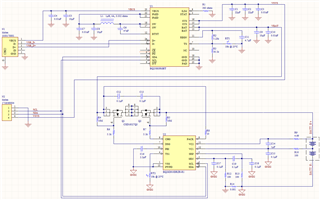Other Parts Discussed in Thread: BQ25883, EV2400, , BQSTUDIO, BQMTESTER
Hello E2E-Community members,
My board has an BQ25883 + BQ28Z610, and I'm using an EV2400 to access them with Battery Management Studio v1.3.101 Build 1.
This is my circuit:

After I assemble the board using brand new ICs, these are the steps I'm taking:
A) Placing the 2x NCR18650B batteries on the circuit.
B) Plugging EV2400 to the board and connecting to BQ28Z610 using bqStudio.
C) Once connected, I click on "Chemistry", select the NCR18650B battery, and click "Program Selected Chemistry".
D) Then I click on "Calibration" and perform a Voltage Calibration.
Now I assume the next step is to perform a Current Calibration. The EVM users guide for the BQ28Z610 tells to apply 2A across the 0.001 ohms resistor (R14 in my circuit), type -2000 on the Applied Current box, check "Calibrate Current" and click "Calibrate Gas Gauge".
Questions:
1) Does the current has to be 2A for the current calibration? Can I apply any other current across the 0.001 ohms resistor, such as 550mA, and enter -550 on "Applied Current"?
2) Should I perform the current calibration with the batteries connected to the board? (I assume yes, but just to make sure)
3) Am I doing this correctly so far? Do I need to set any registers or do anything else besides the learning cycle that goes next?
Thanks in advance

